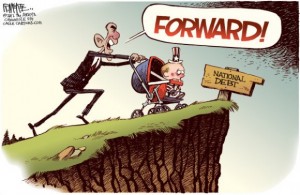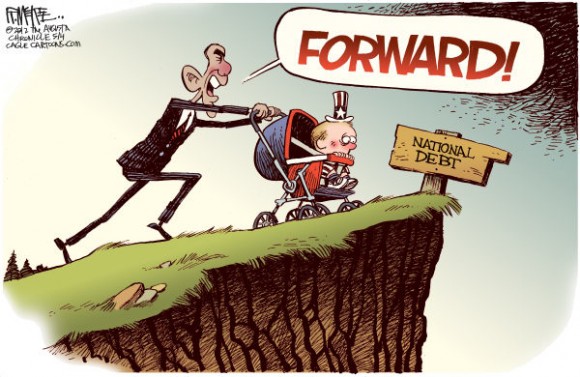 by George Landrith
by George Landrith
President Barack Obama repeatedly chided Mitt Romney’s budget plan during the presidential campaign on at least two grounds: (1) it lacked detail, and (2) the math didn’t add up. Perhaps, we should use these two standards to see how Barack Obama’s plan stacks up. There is more than a little irony in Barack Obama criticizing others for not providing details or for their math not adding up. Obama has always been short on details and his math has almost never passed even the straight face test, much less actually adding up.
Nonetheless, let’s apply these two standards — (1) are there sufficient details? and (2) does the math add up? — to evaluate Barack Obama’s proposals for solving the so-called fiscal cliff.
What detail has Obama provided? The answer is virtually none. His position is that top earners need to “pay their fair share.” He says that top earner should pay more taxes (or higher rates) than the middle class. But the truth is the top earners do pay higher rates than the middle class and they certainly pay their fair share.
The nonpartisan Congressional Budget Office’s most recent study on tax burdens reveals that the ten percent of households with the highest incomes paid more than 70% of all federal income taxes. The remaining 90 percent of American taxpayers only pay 30% of the income taxes. And the bottom 20% of American earners paid less than 1/2 of one percent of federal income taxes paid. That is a rounding error to zero.
Obama also criticized Romney for paying an average effective tax rate of 14% which Obama argued was less than most middle class Americans pay. Obama said, “The fact is that [Romney] only has to pay 14 percent on his taxes when a lot of you are paying much higher.” But that is simply false.
Again, according to the nonpartisan Congressional Budget Office, the average family in lowest quintile (earning $18,400) actually pays no federal income taxes and receives a bonus of 6.8% paid to them. The average family in the second quintile (earning $42,500) also paid no income taxes, but got back a smaller bonus from the government. The average family in the middle quintile (earning $64,500) had an average income tax rate of 3.3 percent — about 1/5 as much as Romney’s 14% rate. Those in the fourth quintile (earning $94,100) had an average income tax rate of 6.2 percent — less than 1/2 has much as Romney’s 14% rate. Those in the highest quintile, which is the group Romney belongs to (earning an average of 264,700) pay an average income tax rate of 14.4%.
So who are all these people in the middle class who pay more taxes or pay a higher rate of taxes than Mitt Romney? Perhaps this is why Obama never got into the specifics — they prove him wrong. Obama provides few, if any, meaningful details, and many of the details he provides are false. Obama fails his own details test. Will the lazy and dishonest media cover this? Never mind.
Now let’s look at the second Obama test — does the math add up? No it does not. And it isn’t even close. Obama claims he wants to go back to the “Clinton-era rates,” but his plan taxes both capital gains and dividends at much higher rates than during the Clinton years. Obama’s plan almost triples the income taxes on dividends from 15% to 43.4%. Likewise, Obama’s plan for income taxes on capital gains is more than 15% higher than the Clinton tax rates. Obama’s math doesn’t add up.
But it doesn’t stop there. When it comes to how to balance the budget, Obama says it cannot be done without increasing taxes on the wealthiest Americans. Yet even if we completely confiscate all the income of the wealthiest Americans, it would hardly make any difference.
The problem is one of spending. But Obama hopes to convince Americans that the real problem is those greedy wealthy people who don’t pay enough taxes — the ones who pay 70% of all federal income taxes.
The budget deficit crisis is clearly a problem of out of control spending, compounded by a stagnant economy. From fiscal 2007 to 2011, federal spending exploded by 32%. During the same period average household incomes dropped by more than $4,000. American’s learned to get by on less, while big government accelerated its spending at historical rates. But Obama won’t admit it is a spending problem.
We could resolve the vast majority of the budget deficit by simply returning to 2007 spending levels. That coupled with some robust economic growth would be a powerful step in the right direction. We had schools in 2007. We had a safety net in 2007. So it isn’t as if returning to 2007 spending levels would be draconian. Let’s be honest, the federal government was spending too much in 2007 too. But at least that would be a serious start.
But Obama says, “We can’t just cut our way out of this hole.” The truth is — big government spent us into this mess and we can cut our way back out. That is just simple math, Mr. President.
Obama portrays his approach of increasing taxes and maybe cutting a little spending as “responsible” and “balanced.” But it is neither responsible nor balanced. And Obama’s math simply does not add up. With his announcement this week that he wants a tax increase now, and next year, he’ll consider possible spending cuts — it is clear Obama has no intention of making the needed spending cuts.
Obama’s plan lacks serious and credible detail. His math does not add up. And worst of all, Obama continues to fail the leadership test.
– – – – – – – – – – – –
George Landrith is the president of Frontiers of Freedom, a public policy think tank devoted to promoting a strong national defense, free markets, individual liberty, and constitutionally limited government. Mr. Landrith is a graduate of the University of Virginia School of Law, where he was Business Editor of the Virginia Journal of Law and Politics. In 1994 and 1996, Mr. Landrith was a candidate for the U.S. House of Representatives from Virginia’s Fifth Congressional District. You can follow George on Twitter @GLandrith.
